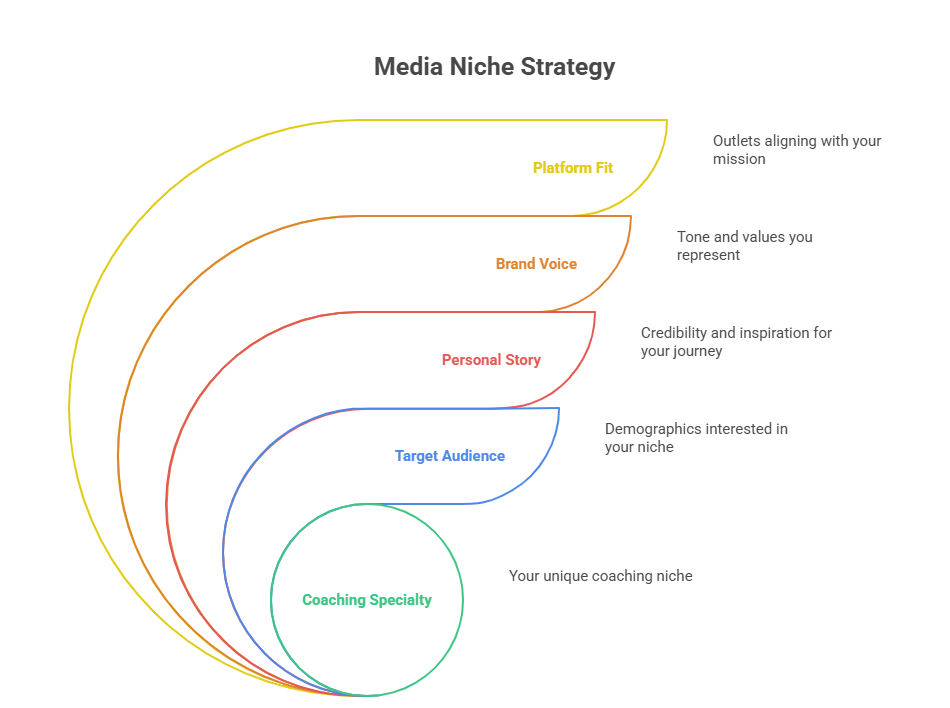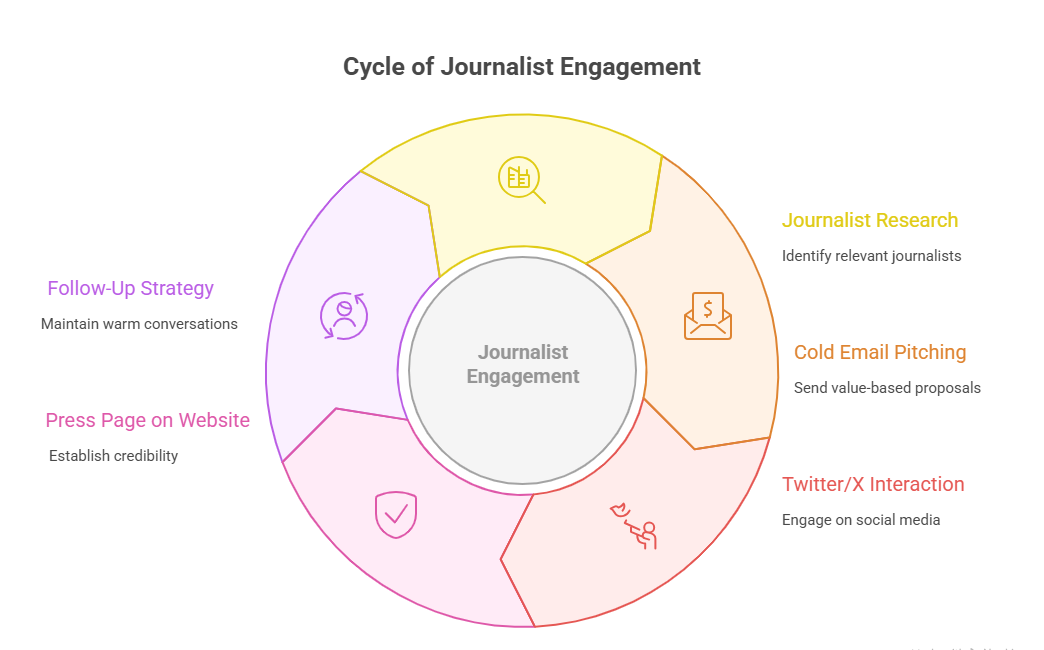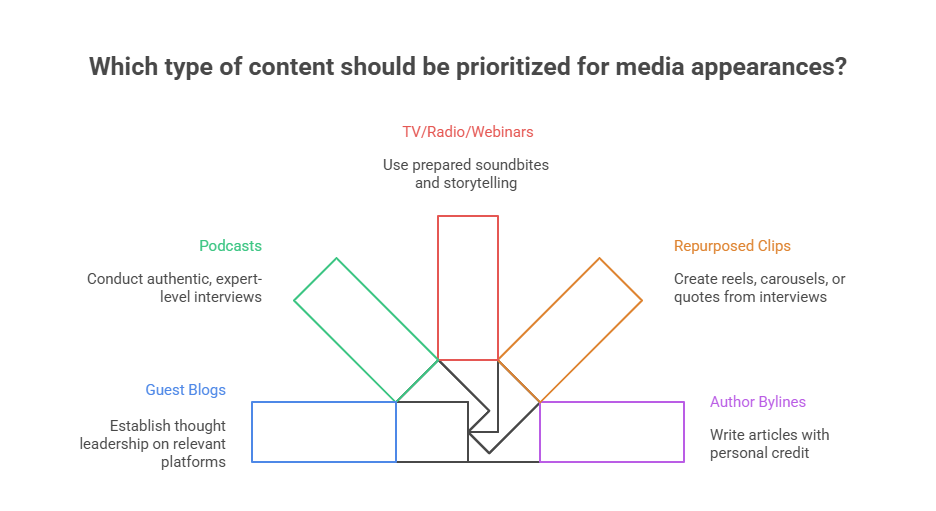How to Get Featured in Media as a Coaching Expert
Getting featured in media isn’t just about visibility—it’s about authority positioning. For coaches, especially in crowded markets, a strong media presence can be the difference between being “just another coach” and becoming a go-to expert. Publicity drives credibility, attracts premium clients, and builds trust faster than any ad campaign.
But it’s not enough to want press. You need to strategically position yourself for it. Journalists don’t care how passionate you are—they care about how your voice serves their audience. Whether it’s a quote in Forbes, a podcast on Spotify, or a live segment on TV, getting featured requires precision, not luck.
This roadmap will show you how.
Identifying Your Media Niche
If you try to be “the coach for everyone,” you’ll end up being the coach for no one. Media outlets look for clear, well-defined voices—not generalists. That means your first step is to own a specific niche that’s both valuable to the public and aligned with your expertise.
Specializing in a Specific Area
What’s your unique lens? Are you a menopause coach helping women navigate midlife transformation? A business coach for introverted founders? Your edge must be razor-sharp. Media doesn’t want the 1,000th mindset coach—they want the only one talking about burnout in female VCs or resilience in medical trainees.
Building a Personal Brand
Once you’ve carved your lane, every digital touchpoint—from your bio to your LinkedIn banner—should reinforce it. Your messaging, aesthetics, and language must feel cohesive. Think: “Would a journalist understand what I stand for in 30 seconds?” If not, refine.
Targeting the Right Audience
Don’t chase Vanity Fair if your audience reads Women’s Health or listens to wellness podcasts. Know where your potential clients and press gatekeepers hang out. Study the media your audience already consumes. That’s where you need to show up with relevance and authority.
Building Relationships with Journalists
Pitching cold without any groundwork is like proposing on a first date. If you want to land media features consistently, relationships come first. Journalists don’t have time for unclear pitches—they trust names they recognize, respect, and rely on for sharp, timely insights.
Researching Journalists and Editors
Before you even write your first email, build a targeted media list. Use tools like Muck Rack or just Twitter/X. Search by beat: health, entrepreneurship, lifestyle, etc. Then study what they write. Understand their tone, preferred topics, and what kind of sources they quote. Tailoring your approach is non-negotiable.
Crafting the Perfect Pitch
Your pitch should feel like a favor, not a favor ask. Lead with a bold insight or compelling stat. Connect your expertise to a trending topic, like “Why female entrepreneurs are burning out faster in the AI era.” Include a clear hook, your credentials, and a short value-driven quote. Keep it under 150 words.
Utilizing Social Media for Media Outreach
Twitter/X and LinkedIn are goldmines for journalists. Engage with their posts, comment thoughtfully, and share their articles. Be a name they see often—before you land in their inbox. DMs are fair game after you’ve built rapport publicly.
Creating Media Appearances and Content
You don’t wait to get featured—you create the spotlight first. When journalists Google your name (and they will), they should find authority-stamped, media-ready content that proves you belong in their story. Visibility begins with strategic contribution, not passive hope.
Guest Articles and Blogs
Pitch bylines to platforms like Thrive Global, Medium, or niche coaching blogs. Your angle must deliver value, not promotion. Think: “How I Helped a Founder Beat Burnout in 30 Days”—not “My 1-on-1 Coaching Services.” Every post should contain a teachable insight, a clear transformation, and a media-friendly voice.
Podcast and Radio Interviews
Start with mid-tier shows before chasing high-profile bookings. Use tools like Podmatch or matchmaker.fm. Focus on shows aligned with your niche, and prep with 3–5 magnetic talking points. Practice soundbites. The media favors voices who can speak in quotable lines—not ramblers.
TV and Webinar Appearances
Even local news channels or niche webinars are leverage points. Record high-quality clips. Repackage them on your website and LinkedIn. This is called social proof stacking—a subtle cue that tells the media, “I’m safe, sharp, and camera-ready.”
Leveraging Your Media Appearances to Build Your Brand
Getting featured is just the beginning. Real value comes when you amplify every appearance across your brand ecosystem. Each media mention should trigger a ripple effect across your website, social content, and lead funnels.
Turn Features into Authority Assets
Create a “Media” tab on your site showcasing your interviews, quotes, and articles. Add publication logos under “As Seen In.” These are credibility triggers that silently boost conversions. Don’t just let features fade—systematize their reuse.
Repurpose Across Platforms
Break a 30-minute podcast down into bite-sized Instagram reels, LinkedIn posts, or quote cards. Mention the outlet every time. Tag journalists. Repost on Twitter/X. This isn’t about bragging—it’s about staying top-of-mind as a trusted expert.
Use Media in Your Sales Funnel
Mention media features in your lead magnets, sales pages, and email intros. Example: “I was recently quoted in Forbes on burnout in executive coaching…” It instantly elevates you from coach to recognized authority—a small shift with massive impact.
| Action | Impact |
|---|---|
| Share on Social Media | Amplifies reach and builds authority |
| Update Website/Press Page | Boosts credibility and SEO |
| Include in Future Pitches | Enhances media trust and validation |
| Use Testimonials from Media | Creates social proof for new audiences |
| Tag & Engage Media Outlets | Increases chances of being reshared |
The Importance of Consistent Media Engagement
One-off media features don’t build a brand—momentum does. If you want to be recognized as a go-to expert, you need a media system, not a random win.
Media Is a Compound Interest Game
The first interview gets you known. The third builds familiarity. The fifth makes you top-of-mind. Each feature compounds trust, especially when your message stays consistent. You’re not chasing fame—you’re building authority that Google, LinkedIn, and audiences remember.
Stay Active, Not Aggressive
Engagement doesn't mean pitching daily. It means staying visible. Comment on journalist posts, publish insights weekly, and follow up on past media wins. Your presence should echo—even between features.
Get Strategic About Timing
Sync your media efforts with product launches, book releases, or live events. Journalists love hooks. Give them a timely angle, not just expertise. Consistent media engagement means you’re never “out of sight, out of mind”—you're always one pitch away from your next breakthrough.
| Activity | Benefit |
|---|---|
| Monthly Guest Posts | Builds thought leadership and traffic |
| Weekly Journalist Outreach | Keeps you visible and relevant in the press |
| Active Social Engagement | Strengthens media relationships organically |
| Quarterly Media Pushes | Aligns with trending topics and news cycles |
| Track Media Analytics | Helps refine strategy and measure impact |
How Your ANHCO Health and Life Coach Certification Boosts Media Credibility
Media outlets don’t just want experts—they want certified authorities. That’s where your Health and Life Coach Certification by ANHCO becomes a key differentiator.
When pitching to journalists, include your certification in your email signature, press kit, and media bio. It gives your expertise weight and shows editors you're trained, not just talk. ANHCO’s certification signals credibility, ethical grounding, and formal education—which makes reporters more likely to quote or feature you.
Many coaches overlook this. Don’t. Highlighting your ANHCO credentials builds instant trust with both media and potential clients. It turns you into a verifiable source, not just another voice in the crowd.
If you’re looking to expand visibility, make sure every article, podcast, or interview includes a line like: “Certified Health & Life Coach through ANHCO.” That single phrase positions you as qualified, vetted, and trustworthy in the eyes of the media.
Frequently Asked Questions
-
Even if you're just starting, you can build authority by leveraging client transformations, sharing expert opinions on trending topics, and consistently posting insights online. Media professionals look for credibility—so regularly contribute content on LinkedIn, Medium, or your own blog. Mention your ANHCO Health and Life Coach Certification in bios and email signatures to position yourself as a trained expert. Join HARO (Help A Reporter Out) to respond to media requests. Every feature—no matter how small—builds your authority. Focus on consistency, clarity, and confidence in your message.
-
Podcasts, print interviews, and guest blog articles offer high credibility and longevity. However, national features (Forbes, NBC, HuffPost) carry more prestige and trust-building weight. Start with niche media like wellness blogs or coaching networks before aiming for larger outlets. The key is alignment—target platforms your ideal client consumes. TV and radio offer visibility, but written articles give you search engine longevity. Repurpose every feature into social content, testimonials, and website sections. It’s not just the placement—it’s how you leverage it strategically
-
Effective pitching starts with research—don’t send mass emails. Instead, personalize your pitch to the journalist’s beat. Include a compelling subject line, a hook that shows your unique perspective, and a clear reason why their audience will care. Mention your certification by ANHCO, include 1–2 social proof points (client result, publication, following), and close with 2–3 sample questions or angles. Avoid bios that ramble—stay punchy and relevant. Journalists are busy—so make it easy to say yes by being concise, credible, and compelling.
-
Yes, many coaches land high-quality features without any agency support. DIY PR is completely viable if you know where and how to pitch. Use platforms like HARO, Qwoted, and Twitter/X to find media callouts. Build relationships directly with editors via LinkedIn. Having a clear media kit, professional headshots, and a one-paragraph bio with your ANHCO Health and Life Coach Certification can fast-track opportunities. Agencies offer leverage but not guarantees. Your story, authority, and pitch clarity are what matter most. Consistency and personalization always beat a generic PR blast
-
Media features build trust—and trust closes clients. Once you’re featured, repurpose the content on your website, sales pages, social media, and email sequences. Use phrases like “As seen in...” above your offer or lead magnet. Add your feature to your bio and pin it to your profiles. Include a testimonial or case study tied to the topic of the feature. People trust coaches who have been vetted by the media. Each appearance should reinforce your transformation promise—not just vanity.
-
Be specific, relevant, and valuable. Journalists get flooded with generic pitches. What stands out is a sharp subject line, a unique take on a trending topic, or a clear benefit to their audience. Include a one-sentence credential mention like “Certified Health & Life Coach (ANHCO) helping busy moms reduce anxiety naturally.” Provide media angles instead of saying, “I’d love to be featured.” Always link to a Google Doc or webpage with past interviews, testimonials, and your bio. Make it easy to say yes by being timely, trustworthy, and brief
-
Getting into top-tier media can take weeks or even months. It’s a compound effort—each small appearance (local blogs, podcasts, guest posts) builds credibility and trust with larger outlets. Some features can happen within days via platforms like HARO, while others might require months of relationship-building and follow-ups. What accelerates success is having a tight niche, professional assets, and strong credentials like the ANHCO Health and Life Coach Certification. Don’t chase only prestige—consistency in media outreach compounds faster than chasing one big feature.
Conclusion
Getting featured in media as a coaching expert isn’t about luck—it’s about positioning, precision, and relentless visibility. You need to know your niche, speak your message clearly, and build trust through consistent content. Journalists don’t chase generalists—they seek experts who bring unique, credentialed perspectives to the conversation.
By identifying your lane, building real relationships with editors, and backing your expertise with your ANHCO Health and Life Coach Certification, you move from being just another coach to a trusted media source. The media is hungry for credible stories—make yours unignorable.
This isn’t about going viral overnight. It’s about compounding visibility that opens doors, builds authority, and brings clients who already trust you. Start pitching. Stay visible. Be relentless.




